
Keep It Fair: Ned Glynn of Sonoma Valley Stables Discusses Trying Horses
Blog
Keep It Fair: Ned Glynn of Sonoma Valley Stables Discusses Trying Horses
When it comes to trying out a prospective horse, Ned Glynn of Sonoma Valley Stables firmly believes in keeping it fair to the horse. Ned has an extensive background in the hunter/jumper discipline, starting as a prominent junior rider. His experiences include coaching the equestrian team at UC Davis, working as an assistant course designer at the Atlanta Olympics and World Cup Finals in Sweden, winning championships, and coaching and training horses and riders to victories at all levels.
Sonoma Valley Stables is a world-class hunter/jumper facility located in East Petaluma, California. Ned has between 40 and 50 horses on his private, family owned property that includes two treadmills, a Eurociser, covered and outdoor arenas, and grass paddocks. The team at Sonoma Valley Stables includes Rebecca Bruce, Ned’s wife. His assistant trainers include Heather Roades, Kylee Arbuckle, Tracy Mirabelli and Debbie Sereni, as well as numerous staff.
All members of the Sonoma Valley Stables team are passionate about what they do and having world-class horses compete in the hunter/jumper discipline. The stables close proximity to the Sonoma Valley Horse Park makes it easy to participate in many of the local shows held there.
Ned’s vast experience trying sales horses provides valuable insights for any equestrian. We asked about his trial process that generates consistent success for Sonoma Valley Stables. Riders can learn from Ned’s techniques and adopt his strategies when seeking their next hunter/jumper partner.

Fanciful and Kylee Arbuckle wins the Franktown Meadows $30,000 International Derby. Owner Emma Townsend. Photography by Alden Corrigan Media
Evaluating the Prospective Sale Horse
Keeping the selection process fair to the horse is the first priority when trying prospective mounts. Do your homework before you go try the horse in person. Evaluating prospective horses should start with a background check on the horse’s results.
“You have to watch video of the horse and know what they’re capable of,” Ned begins. “And, you have to be fair to the horse. When you’re buying a horse, you have goals for where that horse and rider will go. But, you can’t accomplish in a couple of trials where the rider wants to go in six months. It takes time for a horse and rider to become a good team.”
The horse should have the abilities to take the rider where they want to go. But, being fair to the horse means that the rider and trainer recognize that you will not achieve those goals on a trial day. A successful trial focuses on fundamentals and ensures that the horse and rider is a good match. Ned makes sure the horse will fit well in his program during the trial period.
Equestrians understand that you can only learn so much about a horse during the sale process. There’s a level of trust required of the person you’re buying a horse from. Ned prefers to work with people he knows or has purchased a horse from in the past when possible. “I want the seller to be transparent about the horse,” Ned says. “There are no perfect horses, but there are very good horses, they all take a certain approach and program.”

Student Skyler Allen and Winterfell at Sonoma Horse Park. Photography by Alden Corrigan Media
The Test Ride
Riding the prospective horse is a crucial part of evaluating the prospective horse. Ned or the owner/trainer of the horse ride first, and then the client rides. This gives the client an opportunity to watch the horse move and Ned can further his evaluation of the horse. “We start simple with flat work, then pole exercises, and then poles to a jump or two. We focus on the feel of the horse and make sure that it’s a positive experience for the horse and rider.”
Again, the premise of being fair to the horse is paramount throughout the process. “One of my pet peeves is someone trying a horse, and saying that they want a horse jumping three feet, but then they come out to try the horse and are jumping bigger than the rider ever has in the past.” It’s unfair to over face a horse or rider in a trial situation. You will not get an honest assessment of either.
“It’s a learning process the first couple of times you ride the horse,” Ned continues. “We never put a rider into a situation where they’re at a difficulty level above what they’re capable of.” If the first ride goes well, they will go back and try the horse a second time. At the second visit, Ned usually knows within fifteen to twenty minutes if the horse and rider is a good match.
Ned bought Cocon 4, a talented bay mare, in Europe four years ago. He went to Europe to try multiple horses after watching show videos. “I was looking for a jumper. Cocon 4 was the first horse I tried. It was a cold evening in Germany and she was fresh. But, we jumped 10 jumps and I knew I had found my horse.”
He tried twenty other horses throughout Europe before heading back to the stable where Cocon 4 was; Ned tried her again, and then bought her. “I jumped Cocon 4 below her ability level during the trial rides. I knew she could do more but I didn’t ask. Again, the purpose was to make sure she had the aptitude, but focus on fundamentals during the trial. She’s my daughter Avery’s equitation horse now, and they’ve won numerous titles including the THIS Finals at Capital Challenge.”

Avery Glynn and Calle at the Washington International Medal Finals. Photography by Alden Corrigan Media
Ned’s process for trying a horse ensures that he selects the right horse, and that the horse has a long career. Understanding the potential that a horse has is key to purchasing one that will help the rider in achieving their goals.
“When you’re trying a horse, be fair to the horse and be fair to the rider,” Ned concludes. “Know what you’re trying to achieve, but know that you won’t get there on the day of the trial. Keep things fundamental and below the capabilities of the horse and the rider during the trial. Focus on finding the right match with the abilities and potential to go to the next level. I always tell my riders that when you’re trying a horse, ride it like you already own it. Don’t jump too many jumps. Care for that horse like it is already yours.”

Rebecca and Ned. Photography by Alden Corrigan Media
Visit Sonoma Valley Stables at ProEquest!
